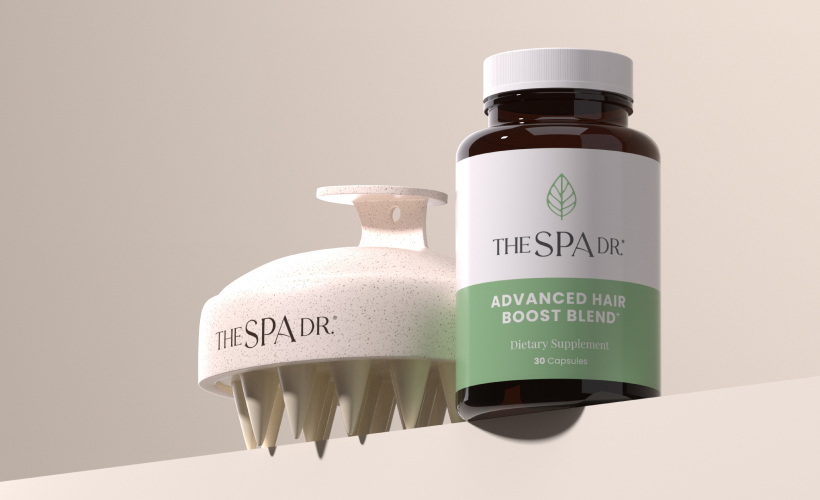Are you looking for a clean, effective, and easy-to-take supplement to support the appearance of thicker, fuller hair?
The Spa Dr. is excited to introduce Advanced Hair Boost Blend, a plant-based, science-backed formula designed to promote healthier-looking hair from within.
Why Choose Advanced Hair Boost Blend?
The Spa Dr. Advanced Hair Boost Blend delivers a powerful blend of nutrients in just one capsule per day.
Featuring biotin, pea shoot extract, saw palmetto, and bamboo extract, this supplement supports scalp and follicle health while encouraging the appearance of naturally thicker, stronger hair—all without animal-based or synthetic ingredients.*
Key Benefits
✔ Supports the appearance of fuller hair – Biotin and pea shoot extract work together to help hair look thicker and stronger.*
✔ Helps reduce the look of hair thinning – Saw palmetto helps maintain hair density, while green tea polyphenols contribute to a healthy scalp.*
✔ Strengthens hair structure – Bamboo extract, rich in silica, helps enhance the look of hair resilience and shine.*
✔ Supports scalp nourishment – Green tea leaf extract provides antioxidant protection and helps maintain healthy blood flow to follicles.*
Science-Backed & Holistic Formula
When it comes to hair health, a truly effective solution goes beyond surface-level treatments. The Spa Dr. Advanced Hair Boost Blend is carefully crafted using a science-backed and holistic approach, combining the power of nature with the latest research in hair wellness.
This advanced formula features a blend of key botanical extracts and essential nutrients—such as pea shoot extract, saw palmetto, and biotin—that work synergistically to support scalp and follicle health for fuller-looking hair from within.*
By nourishing the scalp and supporting overall hair vitality, this one-capsule-per-day supplement provides a convenient, clean, and effective way to help maintain the appearance of healthy hair naturally.*
- Biotin – Supports hair strength and elasticity, and helps reduce the look of breakage*
- Saw palmetto extract (45% fatty acids) – Helps maintain hair density and supports healthy-looking hair*
- Pea shoot extract (Anagain Nu) – Helps promote a natural, fuller-looking hair appearance*
- Bamboo extract – Rich in silica, helps enhance the appearance of hair resilience and shine*
How Advanced Hair Boost Blend Stands Out
Many hair supplements on the market require multiple capsules per day, making them inconvenient for those with busy lifestyles. Advanced Hair Boost Blend offers a more straightforward approach with a one-capsule-per-day formula.
This means you get key nutrients to support the look of healthy hair without the hassle of taking multiple pills. Plus, The Spa Dr.’s formulation is completely vegan, clean, and toxin-free, setting it apart from competitors that may rely on animal-based ingredients.
Additionally, Advanced Hair Boost Blend works holistically to complement topical treatments, meaning you can enhance your results when using it alongside The Spa Dr.’s Hair Serum and Scalp Massager.
Limited-Time Offer: Free Scalp Massager
From March 4 to March 10, 2025, when you purchase Advanced Hair Boost Blend, you’ll receive a FREE Scalp Massager! This tool helps enhance scalp circulation and supports the absorption of hair treatments for even better results.
Enhance Your Routine with The Spa Dr. Hair Serum & Scalp Massager
For optimal hair wellness, pair Advanced Hair Boost Blend with The Spa Dr.’s Hair Serum and Scalp Massager.
The Spa Dr.® Scalp Massager
Maximize your Hair Serum experience with this silicone tool, designed to enhance application and gently massage the scalp for healthy-looking hair.
Our scalp massager:
✔ Helps improve the distribution of Hair Serum
✔ Provides a gentle, relaxing scalp massage
✔ Designed with soft silicone for comfortable use
The Spa Dr.® Hair Serum
Enjoy fuller-looking, healthier hair by supporting scalp hydration with clean, non-toxic ingredients.*
✔ Doctor-formulated with high-quality botanical ingredients
✔ Promotes the appearance of thicker, fuller hair*
✔ Helps reduce the look of shedding and fallout*
✔ Visible improvements in the look of hair health in as little as 28 days*
A Complete Hair Wellness Solution
Healthy-looking hair starts from within, but it also benefits from targeted external care. By combining Advanced Hair Boost Blend with The Spa Dr.’s Hair Serum and Scalp Massager, you’re supporting the appearance of stronger, healthier hair with a comprehensive, inside-out approach.
Invest in your hair’s future today and experience The Spa Dr. Advanced Hair Boost Blend difference!
| *These statements have not been evaluated by the Food and Drug Administration. This product is not intended to diagnose, treat, cure, or prevent any disease. |

